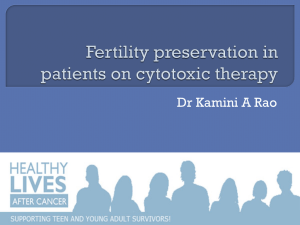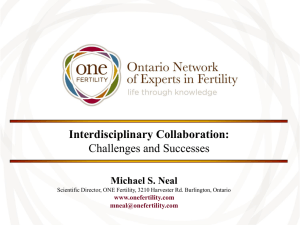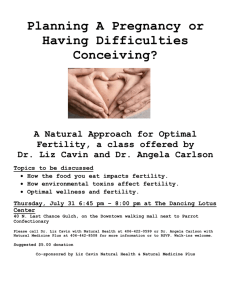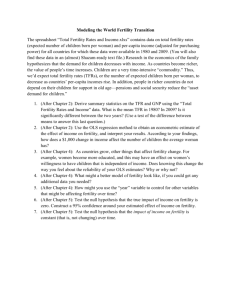National Physicians Cooperative of the Oncofertility Consortium
advertisement
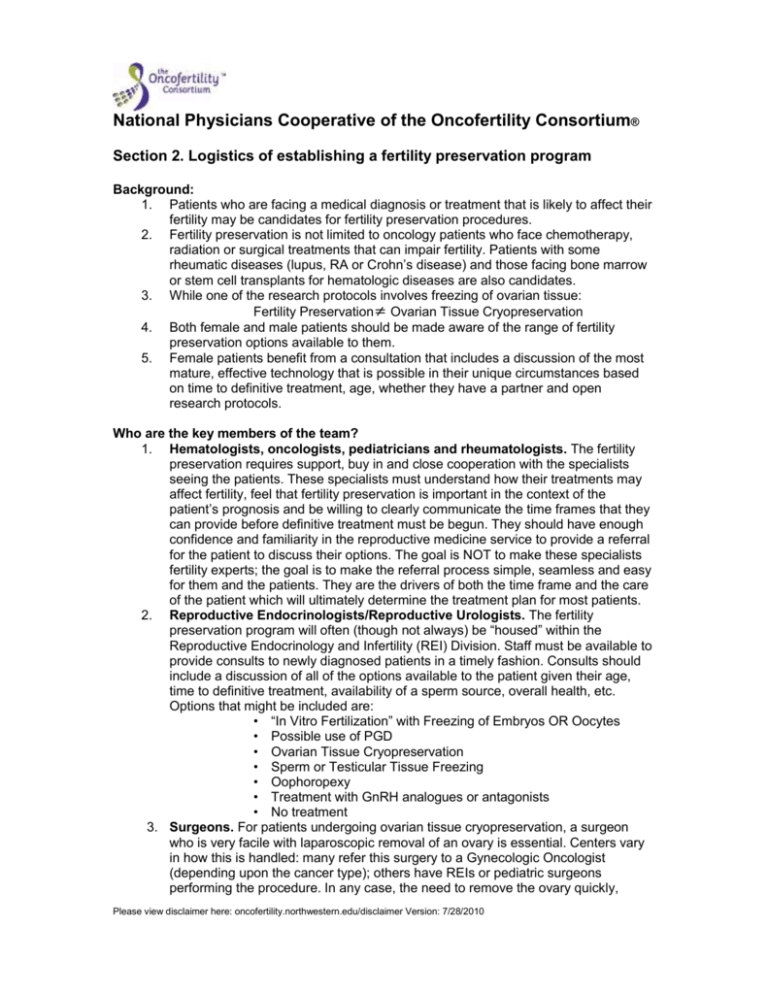
National Physicians Cooperative of the Oncofertility Consortium® Section 2. Logistics of establishing a fertility preservation program Background: 1. Patients who are facing a medical diagnosis or treatment that is likely to affect their fertility may be candidates for fertility preservation procedures. 2. Fertility preservation is not limited to oncology patients who face chemotherapy, radiation or surgical treatments that can impair fertility. Patients with some rheumatic diseases (lupus, RA or Crohn’s disease) and those facing bone marrow or stem cell transplants for hematologic diseases are also candidates. 3. While one of the research protocols involves freezing of ovarian tissue: Fertility Preservation≠ Ovarian Tissue Cryopreservation 4. Both female and male patients should be made aware of the range of fertility preservation options available to them. 5. Female patients benefit from a consultation that includes a discussion of the most mature, effective technology that is possible in their unique circumstances based on time to definitive treatment, age, whether they have a partner and open research protocols. Who are the key members of the team? 1. Hematologists, oncologists, pediatricians and rheumatologists. The fertility preservation requires support, buy in and close cooperation with the specialists seeing the patients. These specialists must understand how their treatments may affect fertility, feel that fertility preservation is important in the context of the patient’s prognosis and be willing to clearly communicate the time frames that they can provide before definitive treatment must be begun. They should have enough confidence and familiarity in the reproductive medicine service to provide a referral for the patient to discuss their options. The goal is NOT to make these specialists fertility experts; the goal is to make the referral process simple, seamless and easy for them and the patients. They are the drivers of both the time frame and the care of the patient which will ultimately determine the treatment plan for most patients. 2. Reproductive Endocrinologists/Reproductive Urologists. The fertility preservation program will often (though not always) be “housed” within the Reproductive Endocrinology and Infertility (REI) Division. Staff must be available to provide consults to newly diagnosed patients in a timely fashion. Consults should include a discussion of all of the options available to the patient given their age, time to definitive treatment, availability of a sperm source, overall health, etc. Options that might be included are: • “In Vitro Fertilization” with Freezing of Embryos OR Oocytes • Possible use of PGD • Ovarian Tissue Cryopreservation • Sperm or Testicular Tissue Freezing • Oophoropexy • Treatment with GnRH analogues or antagonists • No treatment 3. Surgeons. For patients undergoing ovarian tissue cryopreservation, a surgeon who is very facile with laparoscopic removal of an ovary is essential. Centers vary in how this is handled: many refer this surgery to a Gynecologic Oncologist (depending upon the cancer type); others have REIs or pediatric surgeons performing the procedure. In any case, the need to remove the ovary quickly, Please view disclaimer here: oncofertility.northwestern.edu/disclaimer Version: 7/28/2010 Logistics of Establishing a Fertility Preservation Program Page 2 4. 5. 6. 7. 8. without prolonged interruption of the blood supply and in one piece is essential to a good outcome for fertility preservation of the ovary. The surgeon who is placing a port or catheter for another purpose may not be the correct choice. Testicular tissue extraction requires a urologist with experience in obtaining good quality samples. Pediatric Centers. The NPC includes several centers that exclusively serve pediatric and adolescent patients. In these centers, because of patient age, fertility preservation options may be limited to freezing of ovarian tissue, testicular tissue or sperm samples. These centers can remain free standing with removal of ovaries performed by surgeons are skilled at laparoscopic surgery in children. The ovarian tissue can be frozen in a lab that is skilled in freezing of cells and tissues at the pediatric center (e.g. bone marrow) or can be transferred to a nearby adult center for processing. Cell and Tissue Banking Lab Personnel. Freezing of cells and tissues must be performed by laboratory personnel are very experienced in clinical tissue banking. In most centers this will be embryologists, andrology lab personnel, or bone marrow lab personnel and not, generally speaking, research lab personnel or physicians. While training on the specifics of the freezing protocols used will be provided, these personnel should be very familiar with: • Sterile technique and good tissue banking procedures • Tissue dissection and preparation • Addition of cryoprotectant solutions • Loading of tissues into vials • Labeling and documentation • Programming and use of slow cooling freezing equipment • Manual seeding • Storage in liquid nitrogen • Preparation of cryopreserved tissue for shipping • Isolation of oocytes, in vitro maturation (IVM), oocyte and embryo cryopreservation Nurses and research coordinators. Some fertility preservation options are commonly used techniques (IVF, sperm freezing, etc.), others may be covered under a research protocol (ovarian tissue cryopreservation) and some patients may use conventional techniques but might be candidates for one of the social science studies (like filling out a questionnaire about quality of life issues). Experience indicates that the majority of patients will opt for treatment with an established technology and so will be “navigated” through your programs by existing personnel. However, timing is of the essence for these patients so thought must be given to opening up appointments times and treatment groups to them on very short notice. Financial Team. Fertility preservation treatments may or may not be covered by insurance. Your financial team may need to negotiate discounts or case rates or “self pay” package rates for services provided. Most centers have negotiated a “package price” for patients undergoing ovarian tissue cryopreservation which includes: OR time and materials, anesthesia and surgeons fees. These fees are generally patient responsibility. The patient’s choice of a fertility preservation technique may be affected by cost and they should receive information in advance regarding their out of pocket expenses. Marketing and Public Relations. Both patients and the physicians who see them (oncologists, hematologists, rheumatologists) must be educated about how their diagnosis and treatment will affect their fertility, what options are available and how to get to them. In many cases, the options are not new; they are just being made available to a new patient population. Please view disclaimer here: oncofertility.northwestern.edu/disclaimer Version: 7/28/2010 Logistics of Establishing a Fertility Preservation Program Page 3 9. Psychologist. Patients with a new cancer diagnosis or facing a recurrence of a disease may be overwhelmed with amount of new information they must absorb and the decisions that must be made. In pediatric patients, the parents may have additional concerns. Having a psychologist, clinical social worker, etc. available to consult with patients is important. 10. Pathology. Pathologists must be involved early in discussions about establishing an ovarian tissue cryopreservation program so that they have input into how much of the ovary will be available for the patient’s use. Patients who do not have ovarian pathology or genetic predisposition to it, in general, may not require any portion of the ovary to be submitted to pathology. On the other hand, patients with borderline tumors of the ovary or with BRCA mutations may request freezing of the ovary and pathology will require varying levels of sampling. Pathology must be appraised of the tissue requirements for ovarian tissue cryopreservation. Some concepts to keep in mind when freezing ovarian tissue: • When pathology removes their portion of the tissue, they must maintain the sterility of the tissue. • The whole ovary is NOT frozen; the ovarian cortex is the only portion that is frozen, the remainder of the ovary is not usable for fertility preservation. (The cortex is also often the portion that pathology is most interested in). • Areas overlying a “cyst” or mass are often devoid of follicles so tissue from areas that are NOT adjacent to these areas are required for fertility preservation and tissue from the contralateral ovary is preferable. • Optimally, the entire ovarian cortex will be available for freezing and we suggest that when this is not possible the patient not be enrolled in the study. • Knowing that treatment plans sometimes change intraoperatively, IF pathology requires large amounts for examination, we suggest a minimum sample size for freezing for PATIENT’s own use is 6-8 pieces of cortex measuring 5X10X1 mm. (This is suboptimal but is the minimum amount that should be available for the patient). Over and above the patient sample, 20% more must be donated to research to qualify for the study protocol. • Experience indicates that some patients enrolled in the study, preoperatively will not have any tissue available for cryopreservation once surgery occurs (for example, unexpected findings at surgery may mean that the entire ovary is required by pathology for staging). Patients should be made aware of this possibility during the informed consent process. • Pathology will make the final call concerning tissue availability and this may affect the whether a patient is included in the study. • Develop a good working relationship with pathology early. Summary and Conclusions: • To be successful you will need to establish rapport and buy in with colleagues with whom you may not usually interact and who may view fertility preservation as a low priority in the face of a life threatening diagnosis. • Keep the team engaged after the “set up” phase. Finding common ground and ways to continue to make fertility preservation services “user friendly’ are key. • We suggest initiating a standing “Oncofertility Conference” (we hold ours weekly) to discuss upcoming patients, operations, logistics and research. Please view disclaimer here: oncofertility.northwestern.edu/disclaimer Version: 7/28/2010 Logistics of Establishing a Fertility Preservation Program Page 4 Timing, Turnaround and Practical Considerations: Experiences 1. Rapid response to need to scheduling appointments for consultations and procedures. Patients with a new diagnosis of cancer often must enter treatment quickly and obtain information about fertility preservation rapidly. We suggest that you establish a benchmark that all oncofertility patients are seen for a consult within 48 hours of contact (in some cases this may even be too slowly). Whether the patient needs sperm banking before chemotherapy is begun, a consult or surgery scheduled for ovarian tissue cryopreservation it is imperative that you put systems into place to facilitate rapid response. (At NU, we have had more than situation where a patient was diagnosed on a Friday, needed to begin chemo immediately and had to be scheduled for surgery for ovarian tissue cryopreservation immediately.) If you currently have waiting lists for consults or an OR schedule that is nearly impossible to add to, this may not be the time to establish an oncofertility program. 2. Can your IVF program accommodate additional patients and can they be assimilated into the program in a timely fashion? A comprehensive consultation with an REI includes discussion of all fertility preservation options that might be available to a given patient. Time frame to definitive treatment, age of the patient, sperm source availability, etc will dictate the best treatment plan. At NU, we have found that for every 1 patient that enrolled in the ovarian tissue cryopreservation program, 3 patients were best served by IVF with freezing of embryos or oocytes. At NU, this amounts to about 45 additional IVF patients per year who would NOT have been in the REI clinic. All of these patients had to be mainstreamed into the IVF program immediately. For some programs, this might present a major logistical and staffing problem. If your IVF center is at capacity, this may not be the time to establish an oncofertility program. 3. Ovarian Tissue Cryopreservation is a slow freeze method so freezing runs take several hours using a program that differs from that used for embryos or sperm. Tissue processing must begin with an hour of harvesting. In many locations, ovarian tissue cryopreservation will be done in the embryology lab. Ovarian tissue cryopreservation will tie up freezing equipment and personnel for several hours. This should be considered in the context of time of surgery and normal work flow in the lab. For example, if surgery to remove an ovary occurs first thing in the morning, how does this fit with timing of egg retrievals? When are embryos usually frozen (if a slow freeze method is also used for them)? If a freezing run is going on for embryos, how will this affect timely freezing of the ovarian tissue (or vice versa)? If surgeries are scheduled late in the afternoon (as add on cases) how will staffing be affected in the laboratory? 4. Fertility Preservation is a year round service. Providing fertility preservation for patients facing a fertility threatening disease or its treatment is a 365 day a year endeavor. Patients will require consults, treatments and procedures regardless of “downtime” in the lab. If you position your program in your community as the resource for this special patient group, you cannot turn them away because of holiday schedules. You may need to forge an alliance with another (perhaps even competing) program in your locale to provide adequate coverage. 5. Ovarian Tissue Dissection frequently yields oocytes. We have observed that many ovarian tissue dissections (about half) will yield oocytes that are released from the tissue. Your lab must be ready to isolate these oocytes, mature them in vitro (if needed) and cryopreserve the mature oocytes or resulting embryos (if the patient has a partner). 6. What age range of patients can your facility and your staff accommodate? While there is a need to provide adolescent boys and girls (or even children) with fertility preservation options, not all centers are equipped to handle their special Please view disclaimer here: oncofertility.northwestern.edu/disclaimer Version: 7/28/2010 Logistics of Establishing a Fertility Preservation Program Page 5 needs and those of their parents. The NPC has a strong core group of centers that specialize in Pediatric and Adolescent patients, and we encourage you to refer patients to those centers. If you are a center that usually handles adults consider concepts like: • Are your sperm collection rooms (and the printed materials/videos therein) appropriate for adolescents and how would their parents view them? • Is your staff comfortable and conversant with discussing reproductive issues with adolescents and their parents? • Are they comfortable examining virginal patients? Discussing concerns about loss of virginity with patients or their parents? • Are you comfortable balancing a teenager’s confidential information about level of sexual activity or infectious disease status with parents present? • Will the presence of adolescents or children in your office affect your staff or your patients? 7. Are the members of your staff comfortable caring for potentially ill patients? Procedures that are relatively straightforward for fertility patients (e.g. oocyte retrievals) may be more clinically demanding in a patient with leukemia, for example. 8. What if I have patients who want to donate all of their tissue for research (don’t want to retain any for their own use)? The NPC has a template for an IRB submission for patients donating all of their tissue to research (e.g. patients undergoing removal of an ovary for risk reduction). This tissue all goes into the research pool of NPC and is available for research studies that have been approved by the Steering Committee. Centers submitting tissue under this protocol will also receive $500 for the time and effort involved in obtaining the tissue sample. Please view disclaimer here: oncofertility.northwestern.edu/disclaimer Version: 7/28/2010
